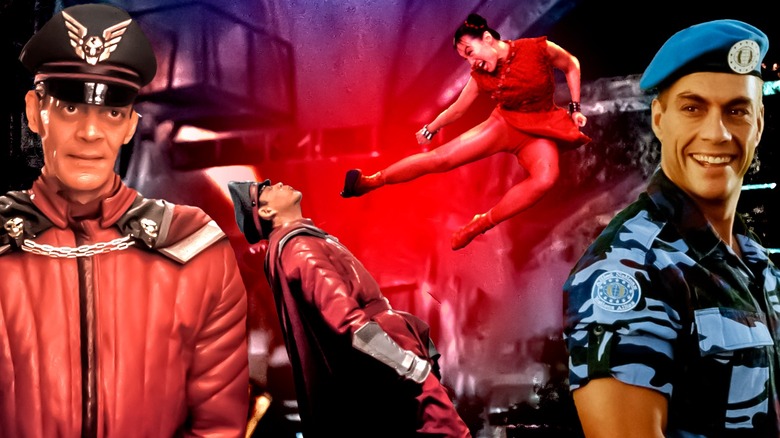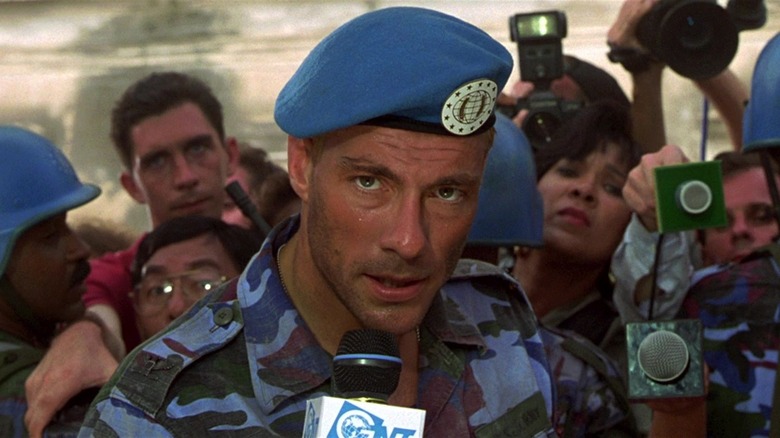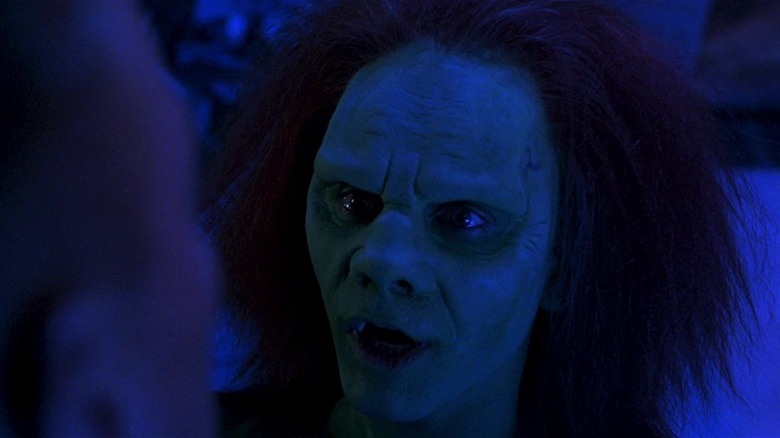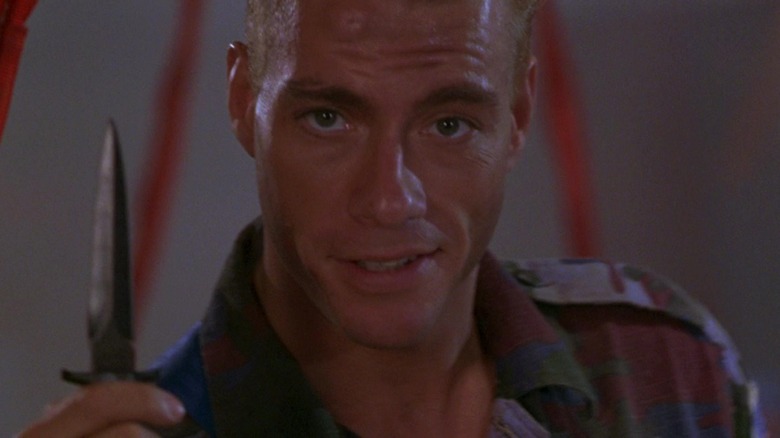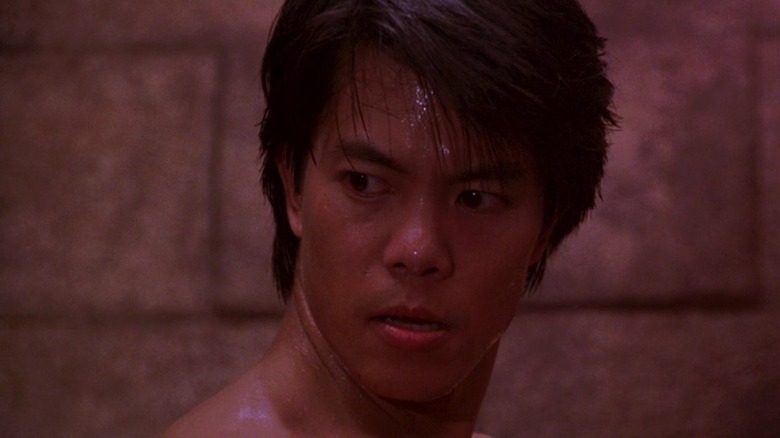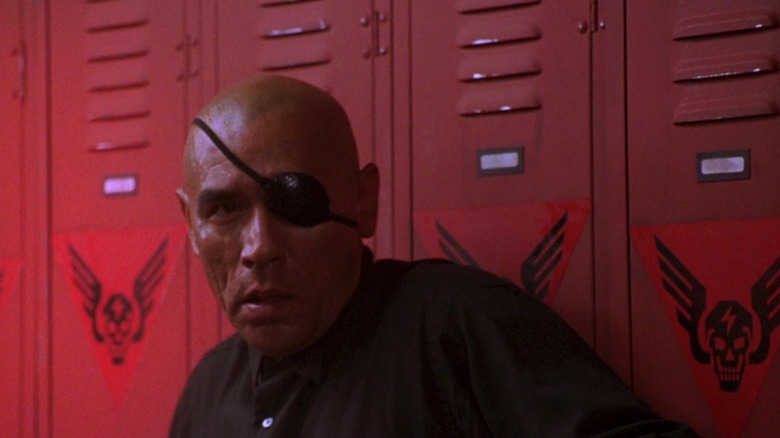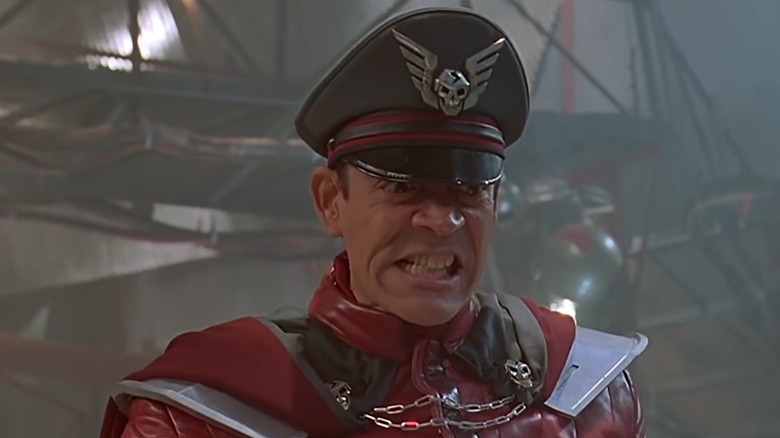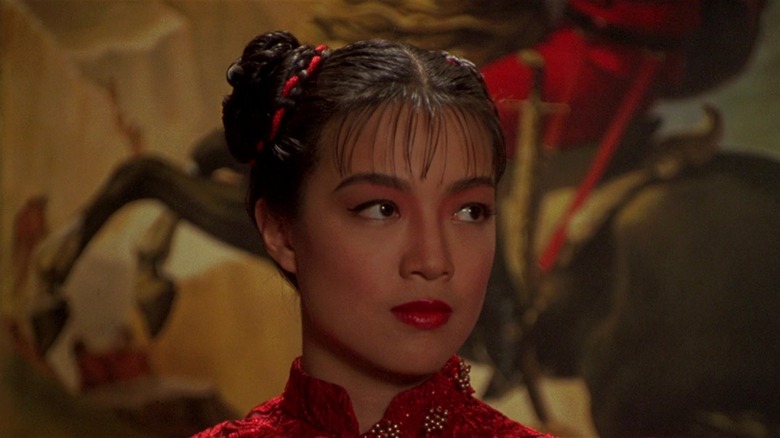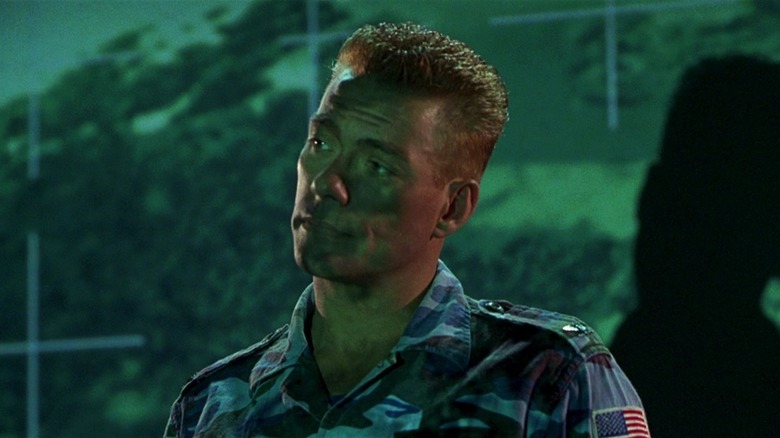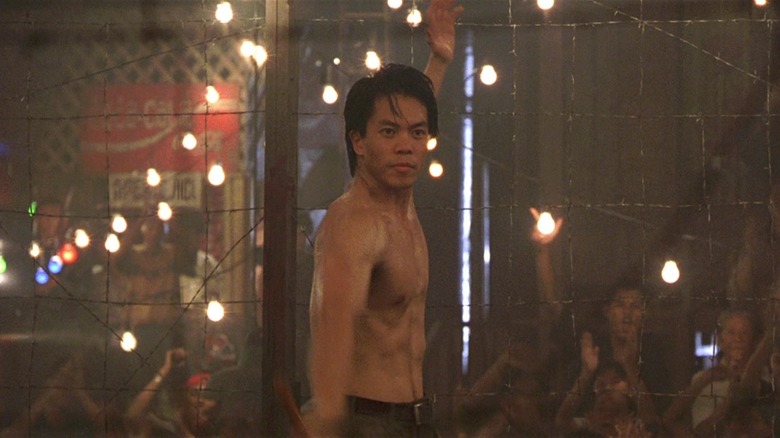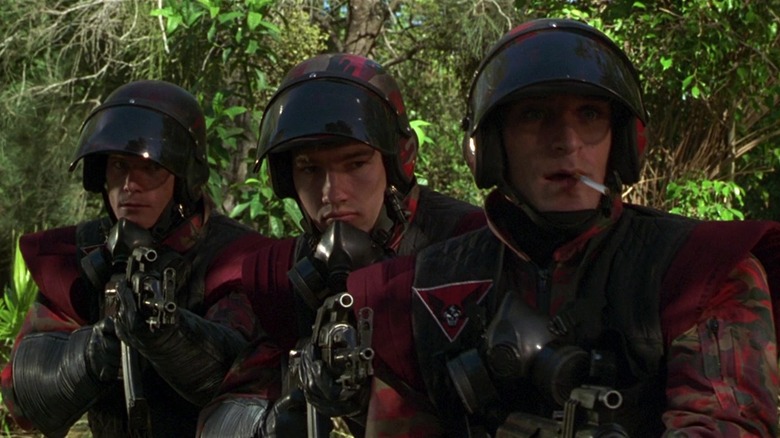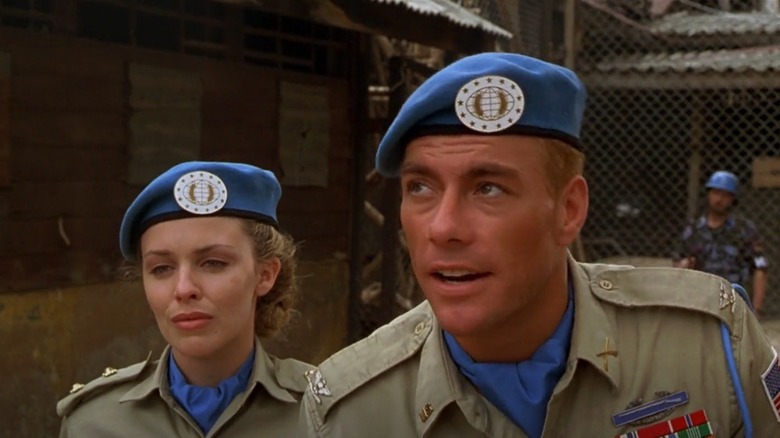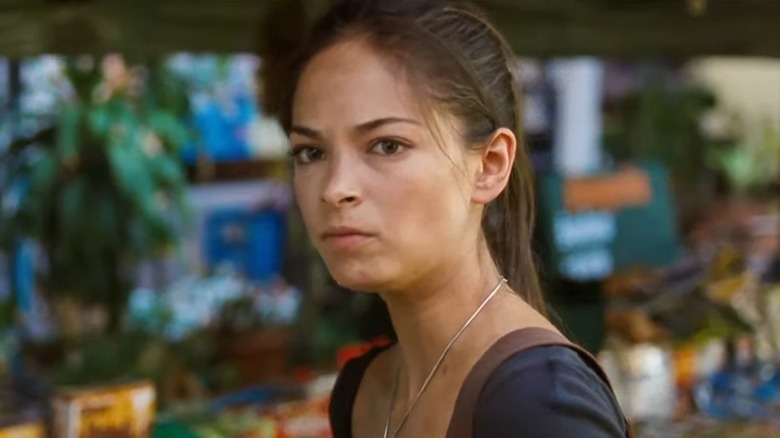Street Fighter: The Complete History Of The 1994 Jean-Claude Van Damme Movie
The year 1994 may have been known for Michael Jackson marrying Lisa Marie Presley and the first genetically engineered tomatoes being available for sale, but a more pivotal moment in human history occurred. It was the release of Steven E. de Souza's "Street Fighter," starring Jean-Claude Van Damme as Col. William Guile and Raul Julia as M. Bison. The video game adaptation was slapped by critics harder than E. Honda does in the game, but hey, at least it wasn't "Street Fighter: The Legend of Chun-Li," right?
While "Street Fighter" wasn't universally accepted at first, and became a prime example of the video game movie curse, many people have softened their stance on it in the years after its release. After all, it boasts incredible quotes, such as, "For you, the day Bison graced your village was the most important day in your life, but for me? It was Tuesday."
The film is carefree chaos on screen, and the history of its production is largely the same. Considering what happened behind the scenes, it's remarkable that it even made it to cinemas in the end. From JCVD being difficult to work with to Capcom wanting to pick actors, let's take a walk down memory lane and find out more about the 1994 "Street Fighter" movie. Hadouken!
The director and Capcom were on the same page about the concept
Before writing and directing "Street Fighter," Steven E. de Souza had built up an impressive CV for himself as a screenwriter by penning now-legendary action films. From "Die Hard" to "Commando," de Souza was the brains behind many fan-favorite films throughout the '80s and '90s. Naturally, he had the credentials to do something special with "Street Fighter," and he had the support of Capcom, too — well, initially.
Speaking to Bristol Bad Film Club, de Souza revealed how producer Edward R. Pressman contacted him about a potential pitch for Capcom, as the video game giant wanted someone to produce a "Street Fighter" film. While de Souza didn't have much time to think about it — less than a day, to be exact — he received supplementary materials from Capcom, demonstrating several James Bond-esque elements it envisioned for the movie. Additionally, de Souza had access to plans for an upcoming toyline, which he noted were similar to "G.I. Joe."
Utilizing his knowledge of the property and the material on hand, he crafted a pitch that hit the sweet spot. Everyone seemed to be in agreement with the direction of "Street Fighter" — until they weren't.
Street Fighter and the concept of the seven dwarves
In 1994, the average blockbuster hovered around the 90- to 100-minute mark. It was a time when films were far more compact, as the stories needed to be lean and get to the point far quicker than nowadays. As a result, Steven E. de Souza knew he would need to carefully select which "Street Fighter" characters were featured in the movie, since it would be impossible to include everyone from the video game series — or would it?
As de Souza revealed to Polygon, he received pressure from Capcom to find space for all the characters from the game. It isn't too difficult to figure out why, as more characters translates to more merch and action figures. In an effort to explain how this would damage the movie's storyline, de Souza asked the executives to name all the seven dwarves from "Snow White," and they struggled.
"There's a reason there's seven dwarves," he said. "There's a reason there's seven wonders of the world. There's a reason it's the 'Magnificent Seven,' which is a remake of the Japanese movie 'The Seven Samurai.' Seven is the number of characters an audience can keep in its head at any time." His rationale convinced Capcom at first; however, as time passed, the video game company kept asking him to add more and more characters.
Why Jean-Claude Van Damme was cast as Guile in Street Fighter
In the video games, Guile is an all-American soldier with the greatest flattop hairstyle next to Will Smith's slick look in "The Fresh Prince of Bel-Air." While it might have been difficult to replicate such outstanding hair in a live-action adaptation, it was more surprising to see Jean-Claude Van Damme cast as the character, considering his thick and distinctively non-American accent.
Speaking to "A Trip to the Movies with Alex Zane," Steven E. de Souza discussed the specific reason for Van Damme's casting. "[Capcom] wanted a big action star," he said. "Originally, they said, 'Can you get Stallone? Can you get Schwarzenegger?' And we just said, 'You can't afford them.' They had a budget of $30 million — we ended up going a little bit over; [we] couldn't afford those guys. So by process of elimination, they finally said, 'What about Jean-Claude Van Damme?'"
The filmmaker thought they could make that casting work, especially since Van Damme wouldn't need to be present for the entire shoot. To explain the accent, though, de Souza conjured up a plan: There would be a brief explanation that he was from Louisiana. Unfortunately, while editing the movie, they removed that line from the final cut and forgot about it.
Capcom's original choice for Ryu
Arguably, Ryu is the most important character in the entire "Street Fighter" franchise. He is the focal point of the main narrative arc and one of the most iconic characters in video game history — full stop. While Ryu plays more of a supporting role in the movie, making way for Guile to be the star, it was still an important part to cast and get the right actor attached to. In the end, Byron Mann was cast in the role, but Capcom wanted a different actor as Ryu.
According to de Souza's conversation with The Guardian, Capcom tried to interfere in the casting process several times. The video game company wanted actor Kenya Sawada as Ryu; however, de Souza remained resolute and stuck with Mann. As something of a consolation prize, Sawada received a cameo as a newly created character named Captain Sawada.
Mann, though, noticed there was visible tension between him and Sawada, saying, "I actually met [Sawada] a couple of times while I was going for casting. ... He gave me some real dagger looks." Well, that's nothing that a good Shoryuken couldn't resolve.
The secret trick of Sagat's eye patch
Securing Wes Studi as Sagat in "Street Fighter" was quite the coup at the time. The esteemed actor was coming off a hot streak where he appeared in award-winning pictures such as "Dances with Wolves," "The Last of the Mohicans," and "Geronimo: An American Legend," so to get him to portray one of the biggest antagonists in the franchise was shrewd business. Regardless of any of the negative noise surrounding the film, Studi confirmed he enjoyed himself on "Street Fighter," though there was a major challenge he had to overcome.
In a career-spanning interview with The A.V. Club, the actor explained how he struggled with his balance and coordination due to Sagat having an eye patch, so a crew member got inventive and helped him out. "Initially what we did was drill a very tiny hole in the eye patch, so that my covered eye could see a little bit of something," Studi said. "So that's what kept me from staggering."
Raul Julia was the consummate professional
The "Street Fighter" movie may be considered the Jean-Claude Van Damme gun show, but the true star of the picture is Raul Julia, who accepted the role of M. Bison because his children were fans of the video game. The veteran actor committed to the hammy, camp nature of his part and gave it his all, delivering a performance that stood out even when people didn't exactly like the film. The actor was posthumously nominated for a Saturn Award for his performance.
The actor was one of the director's first choices for the project, besides Van Damme, as Julia brought prestige and gravitas to the production. Steven E. de Souza is extremely complimentary of Julia and his experience working with him. In interviews, de Souza said he thought Julia was a total professional who embodied his classically trained theater experience in the role of dictator M. Bison.
Julia had undergone surgery before the film, causing him to lose a lot of weight before shooting commenced. According to the director, Julia said he was declared healthy enough to continue with the production, so the film crew pushed out his scenes by a few weeks to allow him to gain weight and work out with the trainer. Julia passed away a month after "Street Fighter" wrapped.
Ming-Na Wen didn't want to do action again after Street Fighter
Ming-Na Wen is best recognized for her roles as Fennec Shand in the "Star Wars" universe and Melinda May in "Agents of SHIELD." However, Wen cut her teeth as an action star in 1994's "Street Fighter," where she starred as the iconic character Chun-Li. Her portrayal earned her good reviews, though many audiences probably remember her more for her Marvel and "Star Wars" TV series.
In the 1990s, though, the punishing requirements of "Street Fighter" almost put her off action productions altogether. Speaking to IGN, she said, "I remember that it was an incredibly intense schedule of working out, and training, and many, many tough, hard days fighting. And I remember saying to myself, 'I will never want to do another action project again.'"
Looking back now, Wen is more appreciative of the "Street Fighter" experience and how it helped to prepare her for the demanding roles she has made her own.
Jean-Claude Van Damme was extremely difficult to work with
By the time "Street Fighter" rolled around, Jean-Claude Van Damme was a major Hollywood superstar. He had already kicked his way into the action hall of fame with films such as "Bloodsport," "Kickboxer," and "Universal Soldier," so everyone knew the Muscles from Brussels was the real deal and a bona fide celebrity. Van Damme arrived on set as the lead star of "Street Fighter," but he ended up being a handful for the director and crew to manage due to his substance abuse.
"I couldn't talk about it at the time, but I can now: Jean-Claude was coked out of his mind," Steven E. de Souza told The Guardian. "The studio had hired a wrangler to take care of him, but unfortunately the wrangler himself was a bad influence."
The writer-director said that JCVD took a whole lot of sick days and that he had to figure out ways to keep shooting something else without him around. De Souza also said there were two times when Van Damme went to Hong Kong during the production and came back much later than his agreed-upon return. Roshan Seth, who played Dhalsim in "Street Fighter," recalled incidents when JCVD wouldn't show up because he had to "pump up [his] muscles."
If you or anyone you know needs help with addiction issues, help is available. Visit the Substance Abuse and Mental Health Services Administration website or contact SAMHSA's National Helpline at 1-800-662-HELP (4357).
Despite the drama, Byron Mann felt like the shoot was a vacation
Look, any film production is bound to be challenging. No one can prepare for everything that might go wrong, but it appears as if these events will wait until the people are on set to strike. However, "Street Fighter" seemed to experience the worst kind of luck coupled with a highly pressurized environment, as Byron Mann discussed with Movie Mavericks. "It was a very tumultuous shoot," he said.
The actor explained how the troubled production took place for two months in Thailand and two months in Australia. There was a large group of people working on the film, and the sets were equally as massive as well, he said, so "Street Fighter" naturally had a lot of moving components to manage and control. To make matters worse, the film's line producer had a heart attack, Mann said, and had to leave the film after a month.
Despite all of the setbacks and more drama than "Days of Our Lives," Mann affirmed he had a great time. "It was a very stressful situation, but for me it felt like I was on a big vacation, I was just happy to be on set," he said. "To this day people recognize me from 'Street Fighter.'"
The cast suffered in the heat of Thailand
Some of the locations in "Street Fighter" stand out immediately. They evoke memories from the video games and are noticeably not just sets in the back of a big studio parking lot. Part of the reason for this charm is because a healthy chunk of the movie was filmed in Thailand, which holds many scenic and exotic landmarks.
While Thailand is beautiful to behold, it also boasts high temperatures and different cuisines — something that impacted the actors while they were there. Speaking to Polygon, Byron Mann said, "In Thailand, no one knew it would be that hot and humid. We were malnourished and not accustomed to the food. Everyone lost weight."
The shoot in Thailand wasn't easy, and it was further impacted by a Bangkok power station giving out because it couldn't support the sheer scale of this blockbuster. Eventually, the production headed out to Australia for the rest of the shoot.
Jean-Claude Van Damme admitted to having an affair with Kylie Minogue during the production
Sometimes, romance blossoms in the most unexpected of places. It could be at work as two people share office gossip and bond over coffee. Maybe it could be at the ice rink, as two star-crossed lovers lock eyes as they pirouette past each other. Alternatively, it could happen in Thailand on the set of "Street Fighter."
It had long been rumored that Jean-Claude Van Damme and Kylie Minogue had an affair during the production of the film. However, as is the case with most celebrity rumors, the average person probably brushed it off as a 50/50 chance of being true. In the end, Van Damme was the one who copped to it.
"It would be abnormal not to have had an affair, she's so beautiful and she was there in front of me every day with a beautiful smile, simpatico, so charming, she wasn't acting like a big star," he told The Guardian. "I knew Thailand very well, so I showed her my Thailand."
The long-rumored Street Fighter 2
While "Street Fighter" was far from a critical darling, it did turn a profit at the box office, raking in just under $100 million, about three times its budget. Despite the bad reviews, a sequel was anticipated to enter production in the near future.
On the public front, though, news about "Street Fighter 2" went quiet for the longest time. However, in 2003, Dolph Lundgren let slip to ESPN that he would be teaming up with his "Universal Soldier" co-star Jean-Claude Van Damme for the sequel. Other sites reported on the news as well, adding that Holly Valance was being eyed as a potential lead.
That intriguing project never came to fruition, though. Instead, another "Street Fighter"-related film arrived in 2009 in the form of "Street Fighter: The Legend of Chun-Li." Starring Kristin Kreuk as the titular character, Chris Klein as Charlie Nash, and Neal McDonough as M. Bison, this film had no connection to the 1994 one. Critics and fans tore into it, as it made the original movie look like "Citizen Kane" in comparison.
